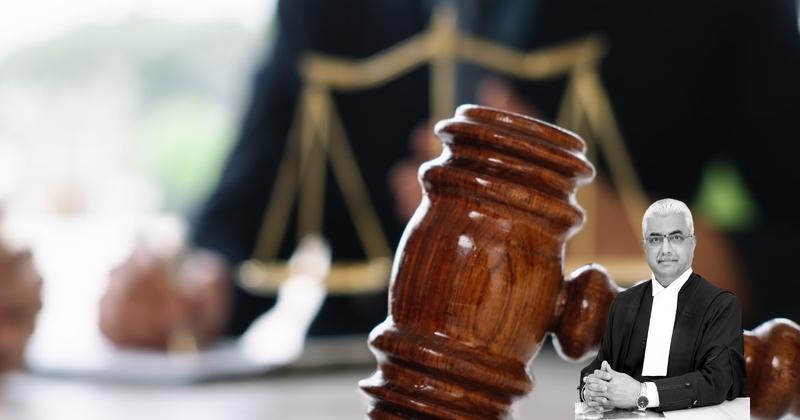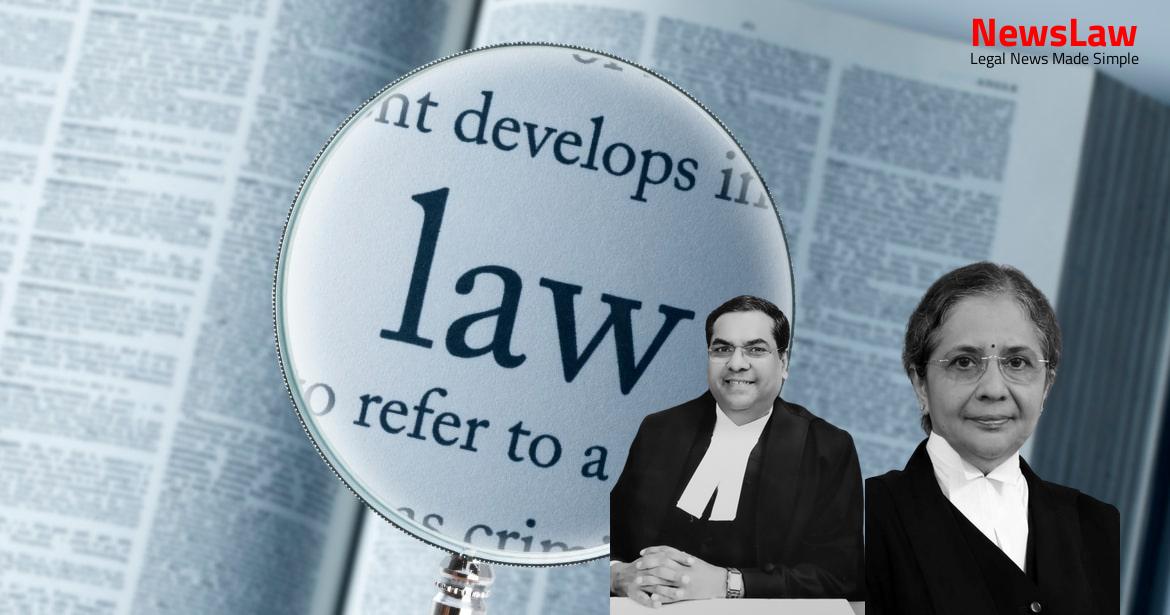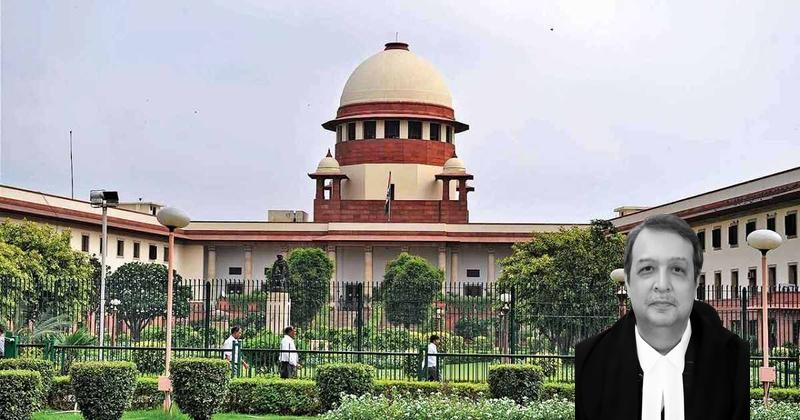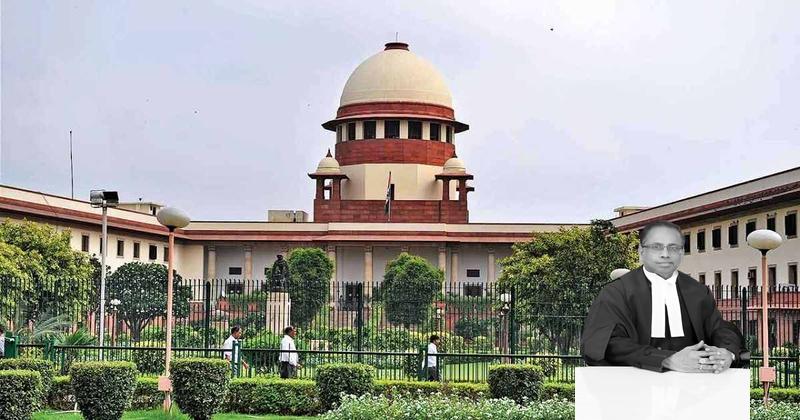This appeal under Section 2(1)(a) of the Supreme Court (Enlargement of Criminal Appellate Jurisdiction) Act, 1970 by the sole accused in Sessions Case No.96 of 2012 on the file of the Fast Track Court, Sagar Taluk, arises from a judgment rendered by the High Court of Karnataka in Criminal Appeal No.335 of 2014 filed by the State of Karnataka against the judgment of the Fast Track Court reversing the order of acquittal and convicting the appellant for the offence punishable under Section 302 of the Indian Penal Code (for short ‘the IPC’), 201 of IPC, 404 of IPC and 419 of IPC and sentencing him to simple 2 imprisonment for life and also sentencing to undergo simple imprisonment for a period of 3 years/2years for the respective offences which has been ordered to run concurrently and also fine. It is further alleged by the prosecution that accused impersonating himself as the son of the deceased person had also attempted to sell the land of the deceased to others and to substantiate his false claims had also handed over the documents of the farm house of the deceased to CW-15 Mr. Charge came to be framed against the accused and same having been denied resulted in trial being held and in order to drive home the guilt of the accused prosecution got examined 25 witnesses as PW-1 to PW-25 and got exhibited material evidence as per Ex.P-1 to P-51 and the 4 material objects as MO1 to MO47.
It was also contended that though recoveries of the articles, namely, material object was at the instance of the accused and the testimony of the witnesses clearly supported the case of the prosecution, yet learned Sessions Judge had erroneously disbelieved the case of the prosecution. On these amongst other grounds as urged in the appeal memorandum the State sought for reversal of the Order of acquittal passed by the Trial Court. He contended that according to the prosecution accused had given a confessional statement at the police station in Malayalam in the presence of PW-10 who translated the same to Kannada and undisputedly PW-10 did not know how to write and read Kannada but was only able to speak Kannada language and as such the translated version of appellant’s alleged confession to the police could not be acceptable evidence. He would contend that confessional statement of the accused was in a printed format and this was not typed in the presence of the accused at the police station and even according to the prosecution it was told by PW-10, written down by the police and undisputedly the statement which was written down was 7 not produced and as such evidence of PW-10 could not have been relied upon by the High Court to convict the accused. He would contend that according to the prosecution the deceased was murdered by the accused on 02.12.2011 as stated in the alleged confession statement and as per the post-mortem report, death had occurred 45 to 60 days prior to days of exhumation on 21.01.2012 and as such the story of the prosecution as attributed to the accused is not believable and on account of the same it caused a serious doubt and the lacuna that has crept in prosecution case has remained unexplained, which was fatal to the prosecution story.
He would contend that very fact of accused having denied all the allegations put against him when he was examined under Section 313 of Code of Criminal Procedure (for short ‘the Cr.P.C.’) including the recovery of the dead body and other material objects at his instance was sufficient to accept the stand of the accused by arriving at a conclusion that prosecution had failed to prove the guilt of the accused beyond reasonable doubt.
Also Read: https://newslaw.in/supreme-court/selection-and-appointment-of-judicial-officers-in-himachal-pradesh/
1
He would contend that the case of the accused was that when he was brought to the spot by the police there were already some people standing exactly at the spot where the dead body was exhumed and accused had not pointed out the spot to the police and the spot was known to the police even before the arrest of the accused. He would contend that on suspicion, conviction cannot be sustained and the prosecution had failed to prove the guilt of the accused beyond all reasonable doubt and by relying upon the following judgments he prays for allowing of the appeal and restoring the judgment passed by the Trial Court: 10 (i) Sharad Birdhichand Sarda v.
He would submit that material witnesses namely the witnesses to the seizure mahazar PW-3, PW-9, PW-11 had remained unshaken and 11 there being no explanation forthcoming in the statement of the accused recorded under Section 313 of Cr.P.C., the High Court has rightly noticed that this material evidence had been ignored by the Trial Court and on account of said uncontroverted evidence available on record it has proceeded to accept the same and convict the accused which finding does not suffer from the vice of error. v State of Karnataka (2005) 7 SCC 714 (iii) State of Karnataka v Suvarnamma (2015) 1 SCC 323 12 (iv) Pattu Rajan v State of Tamil Nadu (2019) 4 SCC 771. Having heard the learned Advocates appearing for the parties and after bestowing our careful and anxious consideration to the rival contentions raised at the bar, we are of the considered view that the following points could arise for our consideration: (a) Whether the judgment of the High Court reversing the finding of the Trial Court is to be set aside on the basis of there being two possible views and the one taken by Trial Court being a possible view? (b) Whether the judgment of the High Court is erroneous and the findings recorded by the Trial Court has been erroneously reversed by High Court while re-appreciating the said evidence?
The expressions “erroneous”, “wrong” and “possible” are defined in Oxford English Dictionary in the following terms: “ erroneous.— wrong; incorrect. So long as the view taken by the trial court can be reasonably formed, regardless of whether the High Court agrees with the same or not, the view taken by the trial court cannot be interdicted and that of the High Court supplanted over and above the view of the trial court.” It need not be restated that it would be open for the High Court to re-apprise the evidence and conclusions drawn by the Trial Court and in the case of the judgment of the trial court being perverse that is contrary to the evidence on record, then in such circumstances the High Court would be justified in interfering with the findings of the Trial Court and/or reversing the finding of the Trial Court.
The Appellate court may reverse the order of acquittal in the exercise of its powers and there is no indication in the Code of any limitation or restriction having placed on the High Court in exercise of its power as an Appellate court. From the above decisions, in our considered view, the following general principles regarding powers of the Appellate court while dealing with an appeal against an order of acquittal emerge: ( 1 ) Such phraseologies are more in the nature of “flourishes of language” to emphasise the reluctance of an Appellate court to interfere with acquittal than to curtail the power of the court to review the evidence and to come to its own conclusion. Secondly, the accused having secured his acquittal, the presumption of his innocence is further reinforced, reaffirmed and strengthened by the trial court. Below the left eye i.e., in the maxilla bone part, swollen wound was found that means some blood clotting mark was found measuring 2 12 inches (length) X 1 12 inches (width).” PW-22 has opined that Mr. It is also the case of the prosecution that deceased had constructed a house in the garden land itself and was residing therein. 3
Contending that prosecution had failed to prove that accused had been employed by the deceased and neither PW-4 nor any other witnesses namely PW-5, PW-6, PW-7, PW-8, PW-9, PW-11 and PW-12 had deposed that they have seen the appellant working in the garden land of the deceased.
When an auto driver, who knew Malayalam, was required in the auto stand I was shown and I and Kafan have acquaintance of nearly 5-6 years. S.P Was there in the station.” The accused was shown to me and asked whether I have acquaintance of the accused and I have identified the accused and stated that he was working in the garden land of Kafan. The accused told that he would show the place where he has buried the dead body and would show the people to whom he has sold the equipments.
Deepak did not know Malayalam and Kafan did not know Kannada and therefore Deepak Gowda took me to talk about the money for JCB and about work. He told me that he wanted workers as there are no workers to work in his garden land. When PW-10 and PW-14 have clearly stated that they had seen the accused in the company of the deceased, and there being no satisfactory explanation offered by the accused to the contrary, it has to be necessarily held that accused had failed to discharge the burden cast upon him. On such reasoning, the High Court held that the circumstantial evidence relied upon by the prosecution was not strong enough to sustain the conviction of the respondent. If he fails to offer an (2006) 12 SCC 254 23 explanation on the basis of facts within his special knowledge, he fails to discharge the burden cast upon him by Section 106 of the Evidence Act. [AIR 1960 Mad 218 : 1960 Cri LJ 620]” 16.6 Thus, when PW-10 and PW-14 have in clear terms deposed to have last seen the accused with the deceased, necessarily accused must offer an explanation as to how and when he started living separately and there being no explanation offered necessarily in the chain of circumstances, the last seen theory propounded by the prosecution to drive home the guilt of the accused requires to be accepted.
— Provided that, when any fact is deposed to as discovered in consequence of information received from a person accused of any offence, in the custody of a police officer, so much of such information, whether it amounts to a confession or not, as relates distinctly to the fact thereby discovered, may be proved.” 18. The statement of an accused recorded while being in police custody can be split into its components and can be separated from the admissible portions. The evidence of the circumstance, simpliciter, that the accused pointed out to the police officer, the place where the dead body of the kidnapped boy was found and on their pointing AIR 1976 SC 483 (2005) 7 SCC 714 26 out the body was exhumed, would be admissible as conduct under Section 8 irrespective of the fact whether the statement made by the accused contemporaneously with or antecedent to such conduct falls within the purview of Section 27 or not as held by this Court in Prakash Chand v.
The evidence of the investigating officer and PWs 1, 2, 7 and PW-4 the spot mahazar witness that the accused had taken them to the spot and pointed out the place where the dead body was buried, is an admissible piece of evidence under Section 8 as the conduct of the accused. Merely because the translation was made from Malayalam to Tamil and written down in Kannada would not suggest that such statement be held to be either not being voluntary or the said statement having been recorded improperly. It is pursuant to this voluntary statement as per Ex.P-2 which lead the police to recover the body of the victim from the compost pit, which has been proved through PW-1, PW-2, PW-4, PW-10 and PW-25. While digging the pit, a cloth was found and while removing the mud a blanket was found after cloth and again while removing the mud slowly a dead body wrapped with a blanket was found.” PW-4: “I have told Stanie that my father has not expired. The accused told that he would show the place where he had buried the dead body and hence led us and showed the place where he had buried the dead body. The accused was shown to me and asked whether I have the acquaintance of the accused and I identified the accused and stated that he was working in the garden land of Kafan.
The accused told that he would show the place where he has buried the dead body and would show the people to whom he has sold the equipments.” PW-25: In his statement, he had admitted about committing the offence and stated that he would show the place where the dead body was buried. Certain articles were recovered on the strength of confession statement – Ex.P-2 made by the accused and in order to prove such recovery the witnesses who have been examined by the prosecution have deposed to the following effect and this has also persuaded us to accept the findings of the High Court. I have purchased 12 spades, one iron rod, and one handsaw, two water drums wherein one had lid and the other one was not having and pest control spraying machine…” (c) PW-10-Kunjali has stated that- “…
Police and Panchas were there when I went to the station and accused and also there. It would be apt and appropriate to extract the deposition of PW-5 which is to the following effect: 32 PW-5: “On 08.12.2011 in the evening Babu called me over phone and told me that rubber roller machine is for sale in Lingadahalli and he is thinking of purchasing it.
He took us to the garden land of Jose Kafan and had shown the rubber roller machine. We did not buy it but came back.” 2 In fact the land belonging to the deceased was attempted to be sold by the accused to PW-5 and the uncontroverted evidence that is available on record is to be following effect below: 33 PW-5: “He told that they will not do any agricultural activities and want to sell property and asked me to inform whether anybody wants to buy it. In order to obtain advice regarding the purchase of the said farm land, I, Lijo and my brother-in-law Bisu met Nagaraj, who is an advocate. Later, after 5 minutes Lijo made a phone call to me and told me to be in bus stand only saying Kafan’s son had called and they could talk directly with him. Then Kolathur Jose told that Jose Kafan is not dead and he would talk to Kafan’s children and let us know about it.”
34 PW-9: “When we went to Kafan’s land, the accused was there. The accused told in Malayalam that he would sell the equipments and Keriyappa understood little bit of Malayalam language. He said that the rubber roller machine is on sale and informed that its cost is Rs. I agreed to purchase the machine and after negotiation it was decided to purchase it for an amount of Rs.
The witness identifies his signature of the accused in M.O.41-agreement. The signature of the witness has been marked as M.O.41(b), accused signature as M.O.41 (c) and Lijo’s signature as M.O.41 (a). Advocate Nagaraj examined the documents and since the advocate was informed that Jose Kafan had died, he informed that Kafan’s children have to come and should bring Power of Attorney from all the heirs and also the death certificate of Kafan. Stanie talked directly and the person who was talking in the phone told that he would come to Sagar to obtain the advance amount. Since the accused did not know both English and Kannada, Lijo translated the contents of sale agreement into Malayalam language and explained to the accused. The accused, who is the vendor, has affixed his signature and the vendee has also affixed his signature. In-fact PW-5 has clearly stated as to how the accused intended to sell the immoveable property belonging to the deceased. On account of evidence available on record having been ignored and there being patent perversity in appreciation of evidence by the Learned Sessions Judge it resulted in interference by the High Court. For the reasons indicated hereinabove we dismiss the appeal and confirm the judgment dated 20.03.2020 passed by the High Court of Karnataka in Criminal Appeal No 335 of 2014.
Case Title: SIJU KURIAN Vs. THE STATE OF KARNATAKA (2023 INSC 378)
Case Number: Crl.A. No.-000064 / 2021



